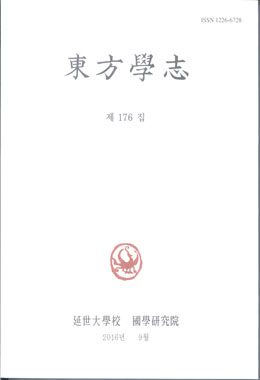학술논문
후쿠오카번(福岡藩)과 통신사(通信使)
이용수 47
- 영문명
- 발행기관
- 연세대학교 국학연구원
- 저자명
- 다카하시마사히코
- 간행물 정보
- 『동방학지』동방학지 제153집, 29~50쪽, 전체 22쪽
- 주제분류
- 인문학 > 문학
- 파일형태
- 발행일자
- 2011.03.31
5,440원
구매일시로부터 72시간 이내에 다운로드 가능합니다.
이 학술논문 정보는 (주)교보문고와 각 발행기관 사이에 저작물 이용 계약이 체결된 것으로, 교보문고를 통해 제공되고 있습니다.

국문 초록
후쿠오카번(福岡藩)은 1636년의 제4차부터 1764년의 제11차까지 통신사를 8회 맞이하였는데, 그때마다 아이노시마(藍島)에 객관을 지어 정중히 응대하였다. 항상 통교(通交)가 있었던 쓰시마번(對馬藩)을 제외하면 이키에서의 접대를 담당했던 히라도번과 함께 일본에서 가장 모범적으로 응대하여, 다른 번에 큰 영향을 미쳤다. 후쿠오카번의 몇 가지 사례를 통해 필담창수의 상황을 살펴보면, 필담창수집의 편집이 자주 미뤄졌을 가능성이 드러난다. 내가 조사한 창화집의 작품 수를 간행본과 사본으로 나누고 그것을 다시 별집(別集: 일본인이 주로 개인적으로 응수하고 있는 내용)과 총집(總集: 일본인이 복수로 응수하고 있는 내용)으로 나누어 보면, 회를 거듭할 때마다 그 필담창수집의 숫자가 늘어났다. 제12차는 쓰시마라는 하나의 나라에서만 응대했기 때문에, 분카(文化) 연간의 필담집이 줄어든 것은 당연하다. 총집의 출판 횟수가 많았던 것은 출판업자가 계획하여 펴낸 것이기 때문이다. 많은 인물이 게재되었다면 꽤 많은 책자라도 팔릴 수 있으리라고 예상했을 것이다. 이에 반해 별집은 개인이 그에 상응하는 출판 비용을 부담하지 않으면 출판하기가 어려웠다. 기념으로 남겨둔 사람이나 지인에게 배포하려는 사람, 스스로 이름을 알리려고 생각한 사람 정도가 별집을 자비 출판했을 것이다. 같은 창화집이라도 간행본과 사본의 형태에 따라 출판 이유가 달라진다. 간행본에 실리지 않은 것과 실릴 수 없었던 것의 의미 차이도 있다. 후쿠오카번에 있어서 쿠시다(櫛田)나 카메이(龜井)는 어째서 간행본에 실리지 않았을까 하는 의문점이 바로 그것이다. 시의 창화가 중심인 책과 필담이 중심을 이루는 책의 차이는 무엇인가. 앞서 나온 어촉서(御觸書)에 따르면 린케(林家)의 서적은 시 창화가 중심이 아닐 수 없다. 히코네(彦根)번처럼 번사(藩士)의 창화를 금지했던 번도 있었다. 막부나 번에 종사하고 있던 학자와 재야의 학자와의 차이는 어디에 있을까라는 시점을 가져볼 필요도 있다. 앞으로는 전체를 파악하고 간행본과 사본 등의 의도를 비교해 나가는 시점이 필요하다는 문제를 제기한다
영문 초록
The Fukuoka clan received Chosen missions to Japan 8 times between 1636 and 1764 and greeted them courteously each time by establishing a visitors house on Inosima Island. Excluding the Tsusima clan, with whom they could always trade, the best relationship was exemplified with the Hirado clan that was in charge of the reception in Iiki. Fukuoka clan along with the Hirado clan also greatly influenced other clans. The possible delay in the editing of collections of exchanged correspondences and poetry may be observed through a couple examples in the Fukuoka clan. My survey focused on the number of collections of exchanged poems by dividing them into published and copied collections. The collections of exchanged poems were also divided according to individual collections of poems (where Japanese people mainly responded individually) and several people s collections of poems (where Japanese people mainly responded jointly). This showed that the number of these collections increased as they were repeated one after another. It is natural that the number of collections of written correspondences made by continuing Boonka publication decreased, as the 12th collection was received only by one county, Tsushima. The reason that the number of jointly shared published collections was large is that the publisher published the collections with planning. I was expected that quite a lot of collections could be sold when many people were included. Contrary to this, the publication of the individual collections was difficult as the individual had to bear the publication expenses alone. Only those wanting to reserve the work as a commemoration, those who would distribute this collection to his acquaintances, and those who would try to make his name known to the public likely published the collection with his own expenses. The reason for publishing changed according to the published and copied collections, even if they were the same collections of exchanged poems. There is also a difference of meaning between the poems not included in the published collections and the ones that could not be included. It is right to inquire why Kushia or Kami in the Fukuoka clan were not included in the published collections. What is the difference between the collections centering on the exchanged poems and the collections centering on written correspondences? According to the previous Afurekaki (the official documents published by the Shogunate or feudal lord to the general publics), the Lin ke books were the ones centering on the exchanged poems. There was also a clan that prohibited the Hansi (samurai employed in the clan) from exchanging poems, as happened in the Hikone clan. It is necessary to clarify the difference in the viewpoints between the scholars engaged in the Shogunate or clan and the non-official scholars. I would like to emphasize that we must understand the significance of these collections as a whole before being able to compare...
목차
키워드
해당간행물 수록 논문
- 일제하 中部幾次郞의 林兼商店 경영과 水産財閥 로의 성장
- 실천하는 문인,성찰하는 학인의 자취 -국문학자 이선영의 삶과 학문
- 후쿠오카번(福岡藩)과 통신사(通信使)
- 1763년 필담자료를 통해 본 에도에서의 문사 교류 - 『傾蓋集』 서문에 보이는 인식을 중심으로 -
- 西周왕조의 族의 재배치와 同姓不婚 -東征 이후 西周王朝의 族 통일정책에 대한 검토-
- 『問차餘響』과 『日觀唱酬』 所載 南玉의 酬應詩 比較 硏究
- 임술(壬戌) 1682년 사행(使行)과 후지산시(富士山詩)
- 상고시기 한반도 서남부와 일본 큐슈지역 간 교류 및 문화적 상관관계
- 일제하 조선.만주의 제당업 정책과 설탕유통
- 최한기와 니시 야마네의 역사철학과 근대적 인간 이해
참고문헌
교보eBook 첫 방문을 환영 합니다!

신규가입 혜택 지급이 완료 되었습니다.
바로 사용 가능한 교보e캐시 1,000원 (유효기간 7일)
지금 바로 교보eBook의 다양한 콘텐츠를 이용해 보세요!





